[Lecture Notes] CMU 15-513 Intro to Computer Systems
Disclaimer: 记得不全,已经会的都没记,不建议用作参考。
My Cheatsheet
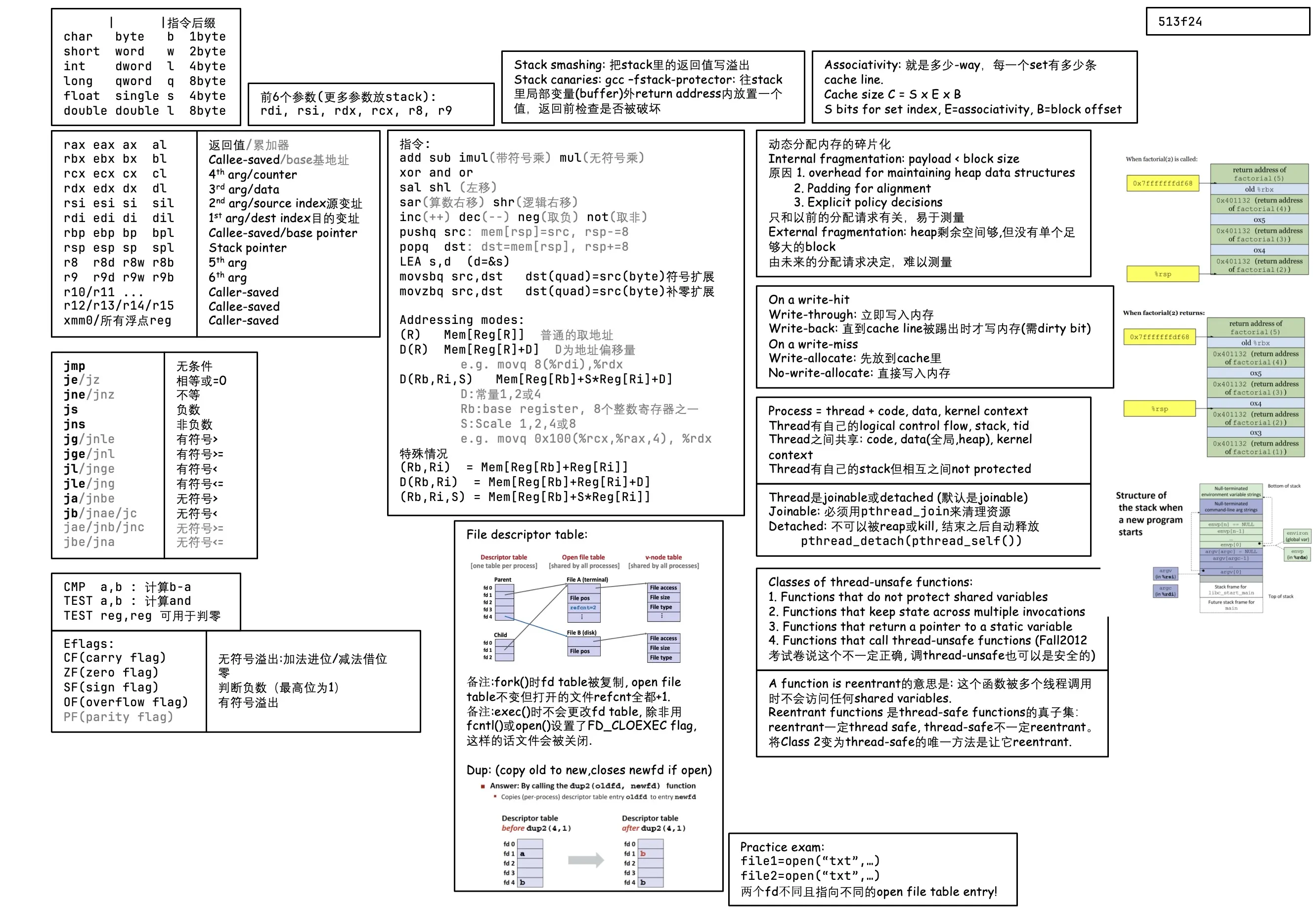
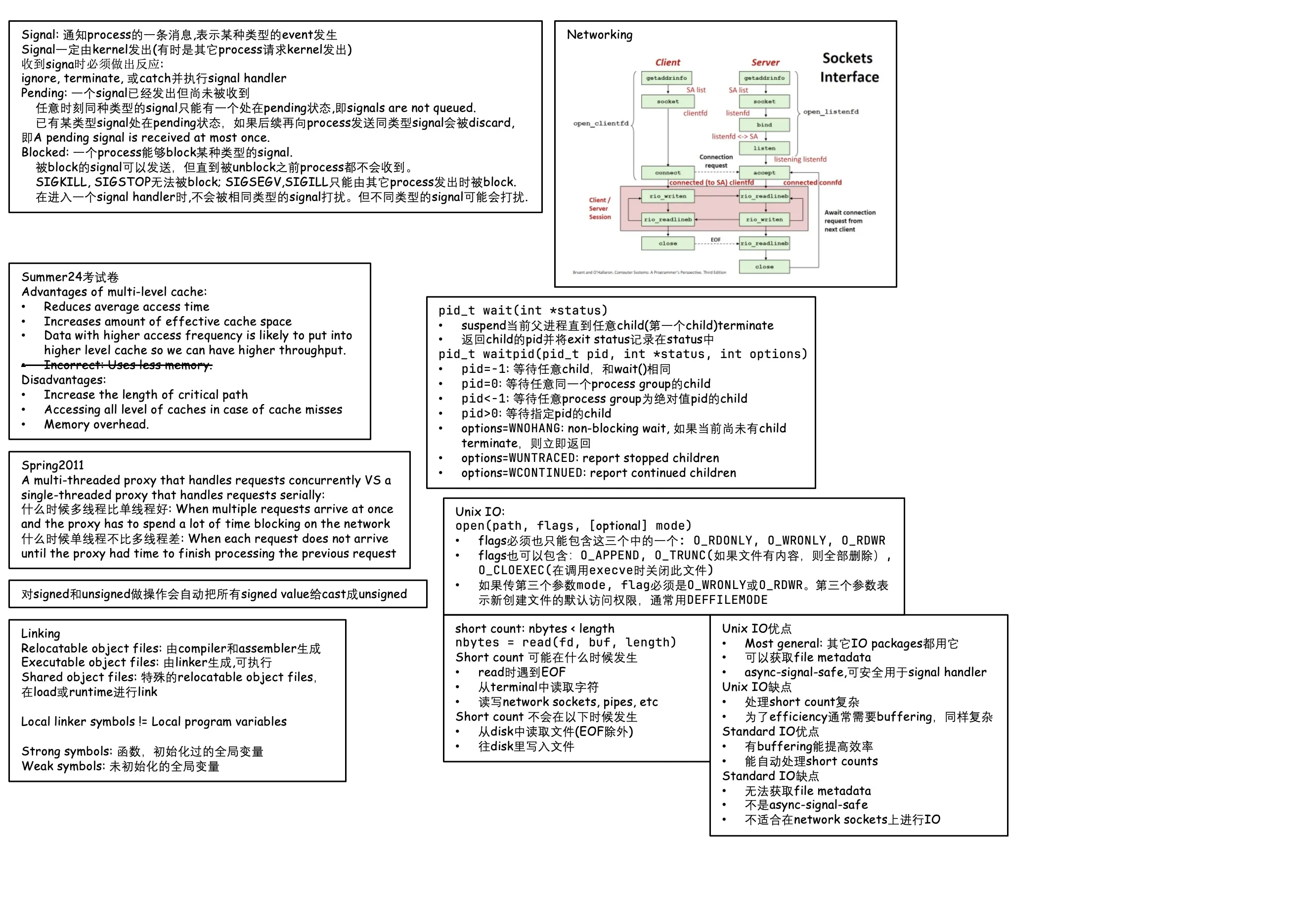
Lec 3. Machine-Level Programming I
- x86-64 integer registers
%rax64-bit%eax32-bit,%ax16-bit,%ah%alhigh 8-bit and low 8-bit respectively- backwards compatibility 向下兼容❎ 历史包袱✅
| Register | Origin (许多已废弃) | ||
|---|---|---|---|
rax (eax, ax, ah, al) | Accumulate 累加器 | ||
rbx ebx | Base 基地址(例如数组首地址 和si di差不多) | ||
rcx ecx | Counter | ||
rdx edx | Data | ||
rsi esi | Source Index (源变址) | ||
rdi edi | Destination Index (目的变址) | ||
rsp esp | Stack Pointer | ||
rbp ebp | Base Pointer | ||
r8 r8d | |||
r9, r10, r11, …, r15 |
关于 bx/bp/si/di 寄存器:
1 | |
Operands 操作数
- Immediate: e.g.
$0x400,$-533(1, 2 or 4 bytes) - Register: e.g.
%rax,%r13.- But
%rspreserved for special use.
- But
- Memory: 8-byte mem at addr given by reg: e.g.
(%rax).
- Immediate: e.g.
movqoperand combinations- ✅ imm to reg:
movq $0x4, %rax - ✅ imm to mem:
movq $-147, (%rax) - ✅ reg to reg:
movq %rax, %rdx - ✅ reg to mem:
movq %rax, (%rdx) - ✅ mem to reg:
movq (%rax), %rdx - ❌ Cannot do mem-mem transfer!
- ✅ imm to reg:
Complete mem addressing modes
D(Rb, Ri, S) = MEM[Reg[Rb] + S*Reg[Ri] + D] (类似二维数组)
D: constant 1, 2, or 4 bytes
Rb: base register
Ri: index register (except
%rsp)S: scale 1, 2, 4, or 8
关于数组寻址
1
2
3
4
5
6二维数组array[10][20]
访问 a[2][3] = a[2*20+3]
a=Reg[Rb]基地址, 2=Reg[Ri](下标i), 20=S (数组是int还是short等)
二维数组 基址变址寻址 (基址rb bx bp, 变址si di)
一维数组
Special case:
- (Rb, Ri) = MEM[Reg[Rb] + Reg[Ri]]
- D(Rb, Ri) = MEM[Reg[Rb] + Reg[Ri] + D]
- (Rb, Ri, S) = MEM[Reg[Rb] + S*Reg[Ri]]
Some arithmetic operations
add,sub,imul(imul带符号乘法;mul无符号乘法)salshl(left shift),sar(arithmetic right shift),shr(logical)xor,and,orinc(++dest),dec(–dest),neg(-dest),not(~dest)lea(load effective address 把存储单元的地址给dst)- CPU designers’ inteneded use: calculate pointer
- Compiler often do: ordinary arithmetic
- e.g.
lea (%rbx, %rbx, 2), %raxmeansrax = rbx * 3.
- e.g.
In most instructions, a memory operand access memory. LEA is exception!
Lec 4. Machine Control
EFLAGS (RFLAGS in 64-bit) register
- CF (Carry Flag): unsigned overflow 进位(+)或借位(-)
- e.g. uint8_t 255+1=0
- ZF (Zero Flag): zero
- SF (Sign Flag): negative 最高位为1 / 判断负数
- OF (Overflow Flag): signed overflow
- 两个正数相加得到负数,或两个负数相加得到正数
- 最高位w,y,
w == y && w != z - e.g. int8_t 127+1=-128
- PF (Parity Flag)
- 一般算术运算会影响所有标志位
- 一般逻辑运算会更改eflags然后把CF和OF置零(因为:逻辑运算只和本位有关)
- 传送类指令
mov,lea等不影响标志位
- CF (Carry Flag): unsigned overflow 进位(+)或借位(-)
Compare
cmp a, b: compute b-a, update condition codessub和cmp唯一的区别在于减出来的差值是否保留
test a, b: compute b&a, update SF and ZFtest和and唯一的区别在于结果是否保留- e.g. 测试某一个bit是否为1,可使用 test reg, 0b000100 指令,接下来使用 jz 判断是否全零
- e.g. test reg, reg 将自己和自己相与,可判断是否自己是零(和 cmp reg 0一致,但硬件层面逻辑运算速度很快,逻辑运算(与门)比算术运算(sub)运算快,因此选择test指令)
Jump
指令 和等效标记 判断条件 (不用记) jmptrue jump 无条件跳转 jejzZF Equal / Zero jnejnz~ZF Not Equal / Not Zero jsSF 负数 jns~SF 非负数 jgjnleZF=0 and SF=OF > (signed) jgejnlSF=OF >= (signed) jljngeSF != OF < (signed) jlejngZF=1 or SF != OF <= (signed) jajnbeCF=0 and ZF=0 > (unsigned) jbjnaejcCF < (unsigned) jaejnbjncCF=0 >= (unsigned) jbejnaCF=1 or BF=1 <= (unsigned) Set
- 将condition codes赋值给寄存器低1字节? 高7字节不会修改
Lec 5. Machine-Level Programming - Procedures
x86-64 stack
pushqsrc: decrement rsp by 8popqdest: increment rsp by 8, copy valuecall label: push return address on stack (address of the next instruction after call), jump to labelret: pop address from stack, jump to that address
传参
- 前六个参数:
rdi,rsi,rdx,rcx,r8,r9 - 更多的参数放在stack中
- 返回值:
rax
Managing local data / 递归函数 Frame
- Stack allocated in Frames
Register Saving Conventions
- Caller Saved (Call-Clobbered)
- rax (return value)
- rdi, rsi, rdx, rcx, r8, r9 (arguments)
- Callee Saved (Call-Preserved)
- rbx, r10, r11, r12, r13, r14, r15 (temporaries)
- rbp (maybe used as frame pointer, can mix & match)
- rsp (special: restored to original value upon exit)
Lec 6. Machine-Level Programming - Data
Arrays 略
Structures 略
Floating Point
- Arguments passed in
%xmm0,%xmm1, … - All XMM reg are call-clobbered (caller saved)
Lec 7. Machine Advanced
Buffer overflow
- #1 technical cause of security vulnerabilities
- #1 overall cause is social engineering / user ignorance
- Stack smashing attacks: overwrite return address, to jump to other code
- code injection attacks: input string contains byte representation of executable code
- How to avoid?
- Avoid overflow vulnerabilities: e.g.
fgets(buf, 4, stdin)instead ofgets - Randomized stack offsets: at the start of program, reposition stack. Makes it difficult for hacker to predict beginning of inserted code.
- Non-executable memory: mark regions of mem as not executable. If jump into such region, immediate crash.
- Stack canaries: 在stack的局部变量和返回地址之间插入一个特殊的标记值canary, 函数返回前检查该值是否被修改.
- Avoid overflow vulnerabilities: e.g.
- Return-oriented Programming attacks (ROP)
- 不插入恶意代码,而是利用现有程序中的代码片段 (gadgets) 通常以
ret结尾
- 不插入恶意代码,而是利用现有程序中的代码片段 (gadgets) 通常以
Union
Lec 8. Design and Debugging
- defect, error, failure (defeat, error not necessarily a failure)
- scientific debugging
- hypothesis, prediction, experiment, observation & conclusion, hypothesis, …
Design
…
TODO
Lec 9. Memory Hierarchy
- The memory abstraction
- bus 总线
- RAM (SRAM / static RAM, DRAM / dynamic RAM)
- DRAM: 1 transistor, 1 capacitor per bit; must refresh state periodically
- SRAM: 6 transistors per bit; holds state indefinitely (but will still lose data on power loss)
- SRAM is more expensive
- Memory hierarchy
- Big idea (ideal): creates a large pool of storage that costs as much as the cheap storage near the bottom, but that serves data to programs at the rate of the fast storage near the top.
- Cache
locality
3 type of cache misses: cold (compulsory) miss, capacity miss, conflict miss
- cold misses: first reference to the block; misses with infinitely large cache
- capacity miss: occurs when the set of active cache blocks is larger than the cache; additional misses from finite-sized cache with no placement restrictions
- conflict miss: occurs when the cache is large enough but too many data all map (by the placement policy) to the same limited set of blocks
Lec 10. Cache Memories
CPU cache memory
- small, fast SRAM-based memories.
General cache organization (S, E, B)
- Cache size = data bytes
- 一条cache line: valid bit + tag + B= bytes per cache block
- 一条地址: t bits - tag, s bits - set index, b bits - block offset
- Direct Mapped cache: E = 1, one line per set
About Writes
What to do on a write-hit?
write-through: write immediately to memory
write-back: defer write to memory until replacement of line (needs dirty bit for each cache line)
What to do on a write-miss?
- write-allocate: load into cache, update line in cache (good if more writes to the location will follow)
- no-write-allocate: write straight to memory
Typical:
- write through + no write allocate
- write-back + write-allocate
When write, the entire block of bytes are written back to memory.
Rearranging loops to improve spatial locality 矩阵乘法为例
description:
1
2
3
4
5
6
7
8
9
10// ijk
for (i=0; i<n; i++) {
for (j=0; j<n; j++) {
sum = 0.0; // variable sum in register.
for (k=0; k<n; k++) {
sum += a[i][k] * b[k][j];
}
c[i][j] = sum;
}
}O(N^3)
假设block size为32bytes (能够存下4个double)
look at the access pattern:
- Stepping through columns in one row:
for (i=0; i<N; i++) sum += a[0][i]- exploit spatial locality, miss rate = sizeof(aij)/B
- Stepping through rows in one column:
for (i=0; i<N; i++) sum += a[i][0]- no spatial locality, miss rate = 100%
- 接下来看内层循环:
sum += a[i][k] * b[k][j];- 这里对于A的访问是stepping through columns, 对于B的访问是stepping through rows
- Miss rate: A 25%, B 100%, C 0%
- 那么总miss per iteration是0.5
- 上面是ijk的情况,同理可得kij也是0.5,而其它 ijk, jik 为1.25, jki, kji 为2.0
- Stepping through columns in one row:
Use blocking to improve temporal locality
code
1
2
3
4
5
6
7
8
9
10
11
12
13
14
15
16
17c = (double*) calloc(sizeof(double), n*n);
for (i=0; i<n; i+=B) {
for (j=0; i<n; j+=B) {
for (k=0; k<n; k+=B) {
// B x B mini matrix multiplication
for (i1=i; i1<i+B; i1++) {
for (j1=j; j1<j+B; j1++) {
for (k1=k; k1<k+B; k1++) {
c[i1 * n + j1] += a[i1 * n + k1] * b[k1 * n + j1]
}
}
}
}
}
}
Lec 11. Virtual Memory
VM is a tool for memory management.
Loading:
execveallocates virtual pages for .text and .data sections, and creates PTEs marked as invalid
page hit: reference to VM word that is in physical memory (DRAM cache hit)
page fault: not in physical memory (DRAM cache miss)
valid bit = 0: page not in memory (page fault)
On page fault:
- valid bit = 0, MMU triggers page fault exception
- handler identifies victim (and, if dirty, pages it out to disk)
- handler pages in new page and updates PTE in memory
- handler returns to original process, restarting faulting instruction
Lec 12. Virtual Memory: Details
Lec 13. Malloc
dynamic memory allocators (such as malloc).
Explicit allocator: application allocates and frees space. E.g. C,C++ malloc, free
Implicit allocator: application allocates, but does not free space. E.g. Java new
The malloc package
- On successful: returns a ptr to mem of at least
sizebytes, aligned to 16-byte boundary (on x64) - Unsuccessful: returns NULL and sets
errno - Other functions:
free,calloc,realloc sbrk: used internally by allocators to grow or shrink the heap
Performance goal: Throughput
- Given some sequence of
mallocandfreerequests, Goal: maximize throughput and peak memory utilization. - Throughput: number of completed requests per unit time.
- Def: Aggregate payload
malloc(p)results in a block with a payload ofpbytes- The aggregate payload is the sum of currently allocated payloads
- The peak aggregate payload is the max aggregate payload at any point in the sequence up to request
- Def: Current heap size
- Assume heap only grows when
sbrk, never shrinks
- Assume heap only grows when
- Def: Overhead
- Fraction of heap space NOT used for program data
Fragmentation
- Internal fragmentation: occurs if payload < block size
- caused by:
- overhead for maintaining heap data structures
- padding for alignment
- explicit policy decisions
- depends only on the pattern of previous requests. Thus easy to measure.
- caused by:
- External fragmentation: enough aggregate heap mem, but no single free block is big enough
- depends on future. Thus difficult to measure.
Implementation
Standard method
- keep the length (in bytes) of a block in the word preceding the block 在分配的block之前存放信息
- word is often called header field or header
- To keep track of free blocks
- method 1: implicit list using length - links all blocks 每个header的位置记录下一个的指针
- need to tag each block as allocated/free
- method 2: explicit list among the free blocks using pointers 存一堆指针
- need space for pointers
- method 3: segregated free list
- different free lists for different size classes
- method 4: blocks sorted by size
- can use a balanced tree (e.g. 红黑树) with pointers within each free block, and the length used as a key
- method 1: implicit list using length - links all blocks 每个header的位置记录下一个的指针
Method1: Implicit free list
每个block的header需要存放size和allocated/free状态,需要两个word,比较浪费
由于分配内存的地址的低几位肯定是0 (因为要16-byte对齐), 所以省略这个低几位,用这几位的空间存放allocated/free 状态。读出size的时候mask out这低几位。
- Finding a free block
- first fit: search list from beginning, choose the first free block that fits
- finding space for
asizebytes (including header) - can cause “splinters” at the beginning of list
- finding space for
- next fit: search starts where previous search finished
- faster than first fit. but fragmentation might be worse.
- best fit: search the list and choose the best free block (with fewest bytes left over)
- keep fragments small - usually improves memory utilization
- typically slower.
- still a greedy algorithm, not optimal.
- first fit: search list from beginning, choose the first free block that fits
- Allocating in a free block: splitting
- 因为需要分配的空间可能小于这一段空余空间,所以可以对block进行split
- 在free的时候,可以只清空allocated block。会导致 false fragmentation (有足够大的连续可用空间,但allocator无法找到)
- Coalescing: join (coalesce) with next/prev blocks, if they are free
- 将free block与紧邻的free block合并
- 如何找到之前的block?
- Boundary tags: 在free block的末尾重复一遍size/allocated信息。
Summary:
- Implementation: very simple
- Allocate: worst case linear time. 所以不在malloc/free中使用。
- Free: constant time (even with coalescing)
Lec 14. Malloc: Advanced
Method2: Explicit free lists
Explicit list among the free blocks using pointers
Maintain list of free blocks, not all blocks.
Lec 15. Code Optimization
Goals of compiler optimization
- minimize num of instructions (remove unnecessary calc, avoid slow instructions)
- avoid waiting for memory (keep in registers, cache-friendly, load data from mem early & only once)
- avoid branching (make prediction easier, unroll loops)
Limits
- generally cannot improve algorithmic complexity
- cannot cause any change in behavior (including edge cases)
- often only analyze one func at a time (exception: inline func)
- tricky to anticipate run-time inputs
Two kinds of optimizations
- Local optimizations: work inside a single basic block (const folding, strength reduction, dead code elimination, local CSE (Common Subexpression Elimination))
- Global optimizations: process the entire control flow graph fo a func (loop transformations, code motion, global CSE)
Examples of optimization
Constant following
Dead code elimination
if (0)remove- overwritten result. e.g.
x = 23; x = 42;
Common subexpression elimination
norm[i] = v[i].x*v[i].x + v[i].y*v[i].y; <!--code4-->
Code motion: move calculations out of a loop (only valid if every iteration produces same result)
e.g.
1
2
3long j;
for (j = 0; j < n; j++)
a[n*i+j] = b[j];optimized:
1
2
3
4long j;
int ni = n*i;
for (j = 0; j < n; j++)
a[ni+j] = b[j];
Inlining: copy body of a func into its caller (but can make code bigger and slower)
Obstacles to optimization
- Memory aliasing: 两个指针或引用引用的是同一块内存,编译器不知道改变一个会不会影响其它
- solution: use intermediate result; or use
restrictkeyword
- solution: use intermediate result; or use
- Can’t move function calls out of loops
Machine-dependent optimization
- Branches are a challenge
- a simple heuristic:
- Backwards branches are often loops, so predict taken
- Forward branches are often ifs, so predict not taken
- fancier algorithms track behavior of each branch
- optimizing for branch prediction
- reduce number of branches (transform loops, unroll loops)
- make branches predictable (sort data, avoid indirect branches e.g. func ptr, virtual methods)
- a simple heuristic:
- Loop unrolling
- Scheduling
- rearrange instructions to make it easier for CPU to keep all functional units busy
- e.g. move all loades (memory) to top of an unrolled loop
Lec 16. Linking
- Why linkers?
- Modularity; Efficiency
What do linkers do?
Step 1: Symbol resolution
- Symbol definitions stored in object files in symbol table
- Linker associates each symbol reference with exactly 1 symbol definition
Step 2: Relocation
3 kinds of object files (modules)
.orelocatable object filea.outexecutable object file.soshared object file
ELF
- standard binary format for object files.
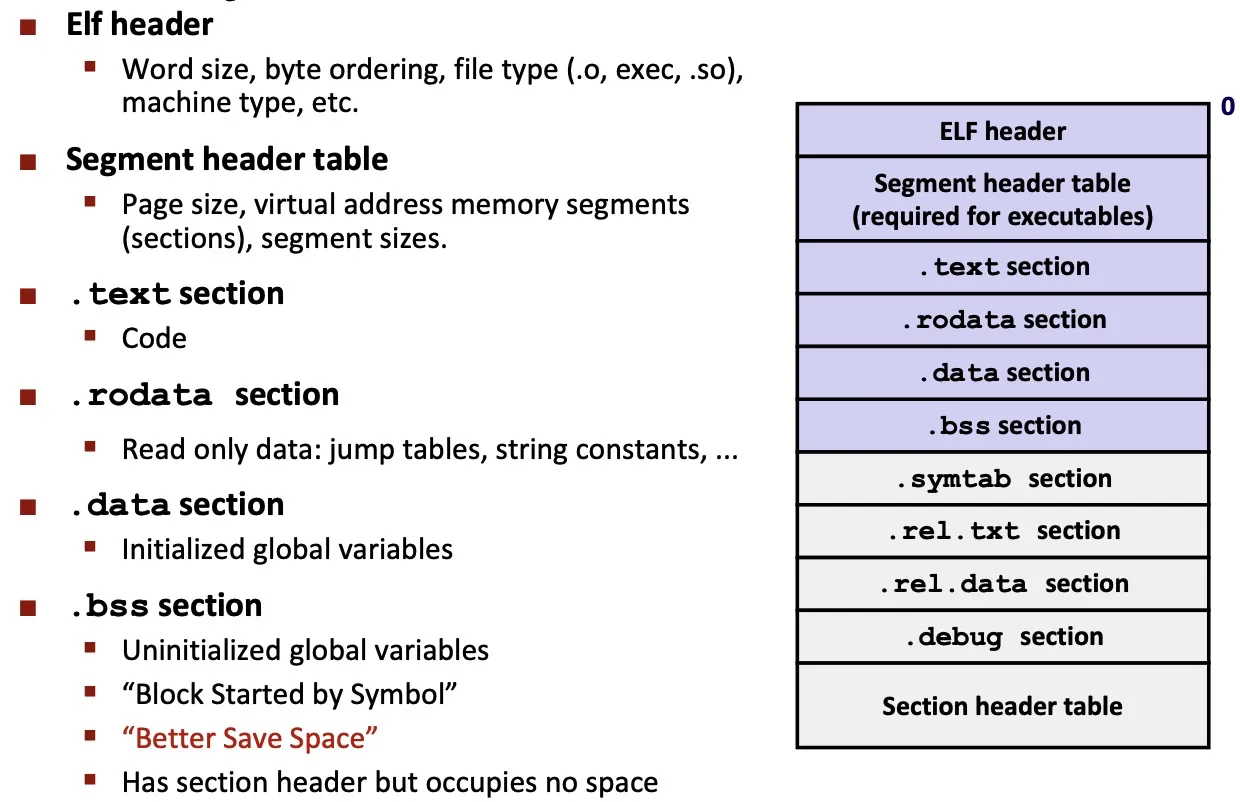
Linker symbols:
- global symbols: can be referenced by other modules
- external symbols: references other modules
- local symbols: within module. Local linker symbols IS NOT local program variables.
Linker’s symbol rules
strong symbol: 函数、有初始化的全局变量
weak symbol: extern变量、未初始化的全局变量
Rule 1: Multiple strong symbols not allowed
Rule 2: Given a strong symbol and multiple weak symbols, choose the strong symbol
Rule 3: If multiple weak symbols, pick an arbitrary one.
- Can override with
gcc -fno-common
- Can override with
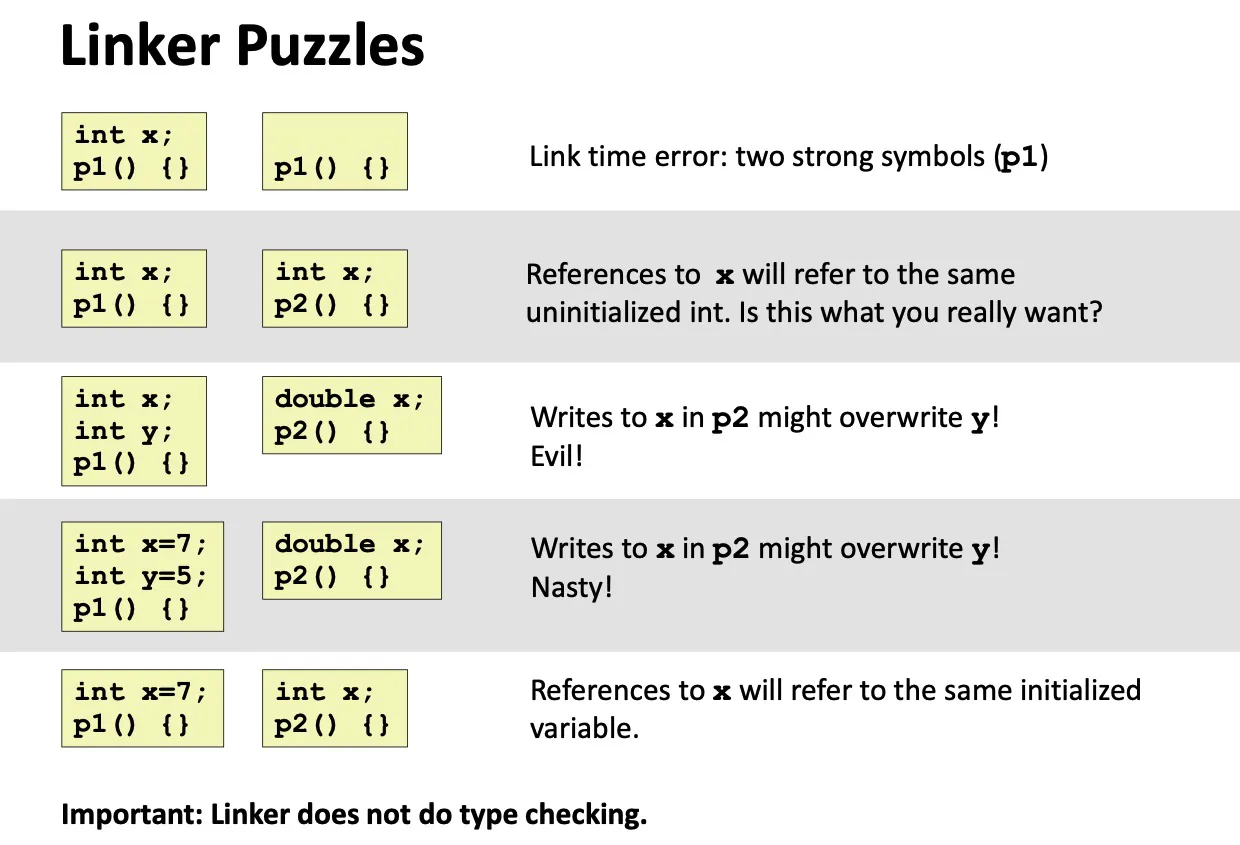
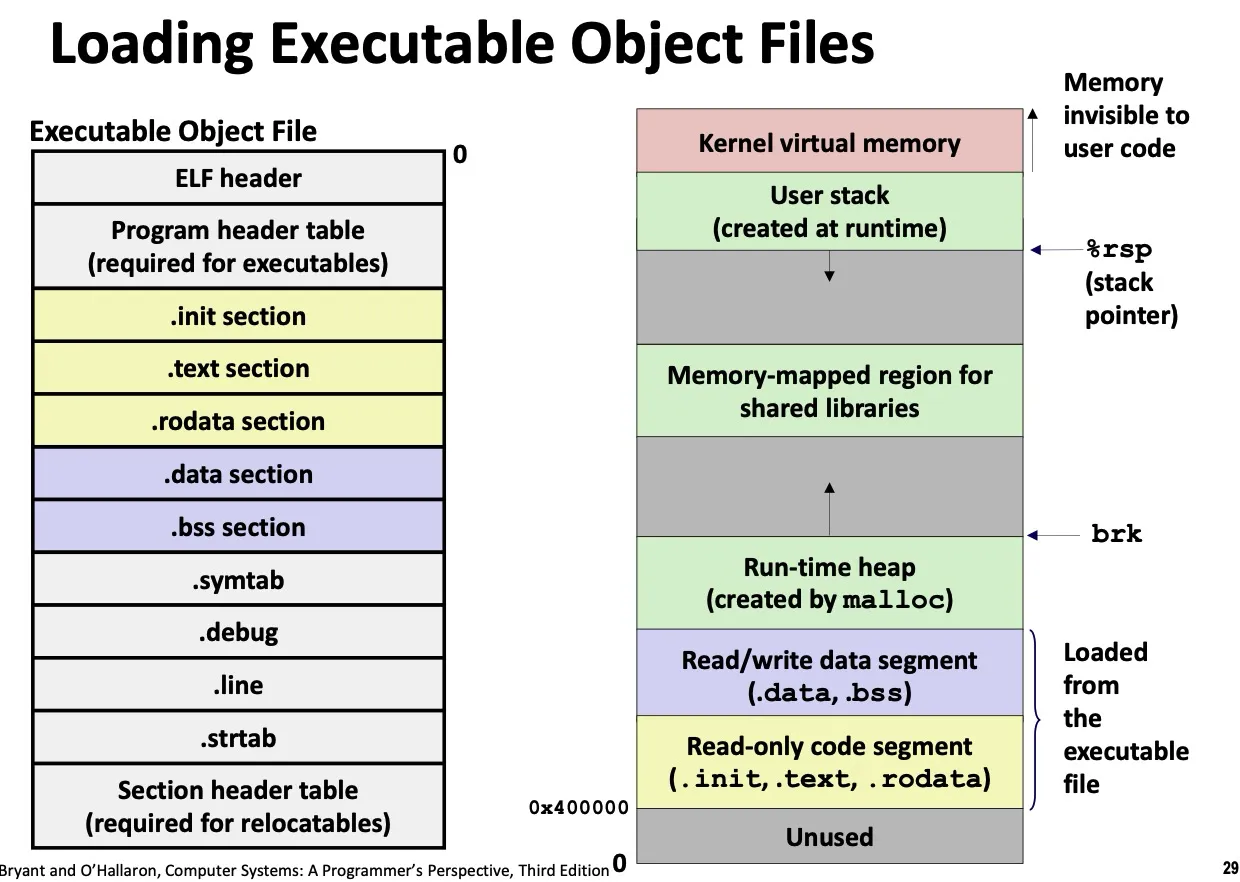
Lec 17. Processes and Multitasking
Processes
Definition: an instance of a running program.
Process provides each program with two key abstractions:
- private address space: process似乎能占用整块内存 (由virtual memory提供)
- logical control flow: 似乎能完全占有cpu运行时间 (由context switching提供)
Processes are managed by kernel
System Calls
On error, most system-level functions return -1 and set global variable errno
Prints outstrerror(errno) to see cause.
Process Control
pid_t getpid(void): 获取当前进程的PID
pid_t getppid(void): 获取父进程的PID
任意时刻,一个process是以下四种状态之一
- running
- blocked / sleeping: 通常是在等IO操作
- stopped: process prevented from executing by user (ctrl+Z)
- terminated / zombie: 进程已结束,但父进程还未收到消息。
- Process become terminated because of 3 reasons
- receiving a signal whose default action is to terminate
- return from
main - calling
exit
- Process become terminated because of 3 reasons
Fork
- returns 0 to child, return child’s PID to parent
- child gets copy of parent’s virtual addr space, opened file descriptors.
Reaping child process
当child terminate的时候仍然会占据系统资源,这个zombine process的exit status和resource storage可能它的父进程还需要,所以会保留。
Reaping: 如果parent用 waitpid() (对于特定child), wait() (对于任意child) 来收集子进程的信息。父进程reaping之后(收集子进程信息之后), 子进程才会被cleanup。
如果父进程结束之后也没有reaping its children,那么一个pid=1 叫做 init 的进程会自动变为父进程。Not a good practice.
SIGCHID: 当父进程的任意一个子进程发生状态变化时,父进程会收到这个信号。默认行为是忽略。可以更改。
状态变化:terminates; is stopped by a signal; resumes
1 | |
wait(): synchronizing with children
pid_t wait(int *status)- suspends current (parent) process until one of its children terminates (always waits for the 1st child to terminate)
- returns PID of child, record exit status in
status- status macros defined in
sys/wait.h:WIFEXITED,WIFSIGNALED, …
- status macros defined in
pid_t waitpid(pid_t pid, int *status, int options)- wait for a specific child or group of children
- pid = -1: wait for any child, like
wait() - pid = 0: wait for any child in the same process group
- pid < -1: wait for any child in process group |pid|
- pid > 0: specific child
- pid = -1: wait for any child, like
- can be told to return immediately if there are no children to reap
- options =
WNOHANG: non-blocking wait. Function returns 0 immediately if no child has terminated yet. - options =
WUNTRACED: report stopped children - options =
WCONTINUED: report continued children
- options =
- wait for a specific child or group of children
execve(): loading and running programs
int execve(char *filename, char *argv[], char *envp[])
- loads and runs in the current process. Overwrites code, data and stack.
envpis the environment variable list,NAME=VALUEstrings.
Lec 18. Exceptional Control Flow
Control flow: 一段顺序执行的指令.
Up to now, two mechanisms for changing control flow: jumps and branches, call and return.
但不足以应对系统,例如IO操作完成、用户按下键盘按键等。
Exceptional Control Flow
- (low level) Exceptions
- Implemented by HW and OS
- Exception: transfer of control to the OS kernel in response to some event
- event: e.g. change in processor state (divide by 0, page fault, IO req completes, …)
- Exception Tables
- 每种类型的event都有一个独一无二的exception number. 查表得知exception的handler。
- 可分为 Asychronous 和 Synchronous
- Asynchronous Exceptions (Interrupts 中断):例如:timer (每隔几毫秒外部计时器自动触发), 用户按下ctrl-c, IO操作读取完成,等
- Synchronous Exceptions: 由某一条指令的执行结果产生,包括 traps, faults, aborts
- trap: Intentional
- 例如system call, GDB断点
- faults: Unintentional, may or may not be recoverable
- page faults (recoverable), protection faults (unrecoverable)
- aborts: Unintentional, Unrecoverable
- e.g. 非法指令、机器自检 奇偶校验失败
- trap: Intentional
- (higher level) Process context switch
- Implemented by hardware timer and OS software
- (higher level) signals
- Implemented by OS software
- (higher level) Nonlocal jumps:
setjmp()andlongjmp()- Implemented by C runtime library
Signals
signal: 通知process的一条消息,表示某种类型的event发生了。
- signal 一定是由kernel发出的(有时是由其它process请求kernel发出)
- kernel发送signal的原因:
- kernel检测到某种系统event,例如除零(SIGFPE)、或者child process停止 (SIGCHLD)
- 另一个process通过kill这个syscall请求给某个process发送KILL signal
收到signal时必须做出反应
- ignore the signal: do nothing (例如SIGCHLD的默认操作是ignore)
- terminate the process
- catch the signal by executing signal handler
- signal handler 由用户指定,执行完signal handler时才去执行下一条本该执行的指令
Pending and Blocked signals
- Pending: 一个signal已经发出但尚未被收到,则为pending状态
- 任意时刻同种类型的signal只有能有一个处在pending状态。Signals are not queued.
- 已有某类型signal处在pending状态,如果后续再向process发送同类型signal将会被discard。A pending signal is received at most once.
- Blocked: 一个process能够block某种类型的signal。被block掉的类型的signal可以发送,但直到被unblock之前process都不会收到。
- SIGKILL, SIGSTOP 无法被block;SIGSEGV, SIGILL 等 can only be blocked when sent by other processes.
- 在进入一个signal handler时,不会被相同类型的signal打扰。例如正在执行SIGINT handler,其无法被另一个SIGINT signal interrupt。
Sending signals: Process Groups
- 每个process只能属于一个process group.
- pgid = process group id
getpgrp(): get process group of current processsetpgid(): change process group of a process
Lec 19. System-Level IO
Unix I/O: 一切皆文件
- Kernel 提供了操作文件的基础方法
open(),close(),read(),write()- 找文件信息 (size, type, last modified time, …):
stat(),lstat(),fstat() - Changing the current file position (seek):
lseek()
- Each file has a type
- Regular file
- 应用程序一般会区分二进制文件和纯文本文件。Kernel不区分。
- Directory
- 由一堆 entries (aka links) 组成。至少有两个entry:
.and.. - Kernel mains current working directory (cwd) for each process. (modifies by
cd)
- 由一堆 entries (aka links) 组成。至少有两个entry:
- Socket
- Named pipes (FIFOs)
- Symbolic links
- Character and block devices
- Regular file
Open/Close files
1 | |
Returns file descriptor (fd == -1 indicates error)
每个process启动时会有三个已经打开的fd:
- 0: stdin
- 1: stdout
- 2: stderr
- These could be files, pipes, terminal, or even a network connection
Ways to call open()
open可以传两个参数也可以传三个参数。O_CREAT 必须传第三个参数,其余情况第三个参数会被忽略。
- 打开已经存在的文件:
open(path, flags)- flags必须也只能包含以下三个中的一个:
O_RDONLY,O_WRONLY,O_RDWR - flags也可以包含:
O_APPEND,O_TRUNC(delete existing contents if any),O_CLOEXEC(close this file if execve is called) 等等
- flags必须也只能包含以下三个中的一个:
- 打开或创建文件:
open(path, flags, mode)- flags必须包含
O_CREAT和O_WRONLY,O_RDWR这两个中的一个。 - flags也可以包含:
O_EXCL(fail if file does exist),O_APPEND,O_TRUNC,O_CLOEXEC等
- flags必须包含
- Third argument gives default access permissions for newly created files.
- Use
DEFFILEMODEunless you have a specific reason to want something else.
- Use
Closing files
- do not close any file more than once
- closing can fail. The file is still closed. The OS is taking this opportunity to report a delayed error from a previous write operation.
Read/Write files
1 | |
Returns number of bytes read. (return type ssize_t is signed integer, nbytes < 0 indicates error)
short counts (nbytes < sizeof(buf)) are possible, and are not errors!
1 | |
Similarly, short counts are possible and are not errors.
Short counts
Short counts can occur in
- encountering EOF on reads
- reading text lines from terminal
- read and write network sockets, pipes, etc.
Short counts never occur in
- reading from disk files (except for EOF)
- writing to disk files
Best practice is to always allow for short counts.
Standard IO
- unix io:
open,close,read,write - standard io:
fopen,fclose,fread,fwrite,fgets,fputs,fscanf,fprintf
Standard IO open files as streams (abstraction for fd)
C program begins with three open streams (defined in stdio.h):
extern FILE *stdinextern FILE *stdoutextern FILE *stderr
Buffered IO: motivation
- Applications often read/write 1 char at a time
getc,putc,ungetcgets,fgets(read line of text 1 char at a time, stop at newline)
- Unix IO calls are expensive (
readandwriterequires unix kernel calls, >10000 clock cycles) - Solution: Buffered IO
- Buffered read
- Buffered write: buffer flushed to output fd on
\nor call tofflushorexitor return frommain.
Which IO when
Unix IO Pros
- most general. All other IO packages are using it.
- can access file metadata
- async-signal-safe and can be used safely in signal handlers
Unix IO Cons
- Dealing with short counts is tricky and error prone
- Efficient reading requires buffering, which is also tricky and error prone
Std IO Pros
- Buffering increases efficiency
- short counts handled automatically
Std IO Cons
- no function for accessing file metadata
- not async-signal-safe
- not appropriate for io on network sockets
Aside: never use the following on binary files:
- Text-oriented IO:
fgets,scanf,rio_readlineb, … - String functions:
strlen,strcpy,strcat, …
Metadata, sharing and redirection
Metadata maintained for each file. Access with stat and fstat.
File sharing: two open file table points to the same v-node table
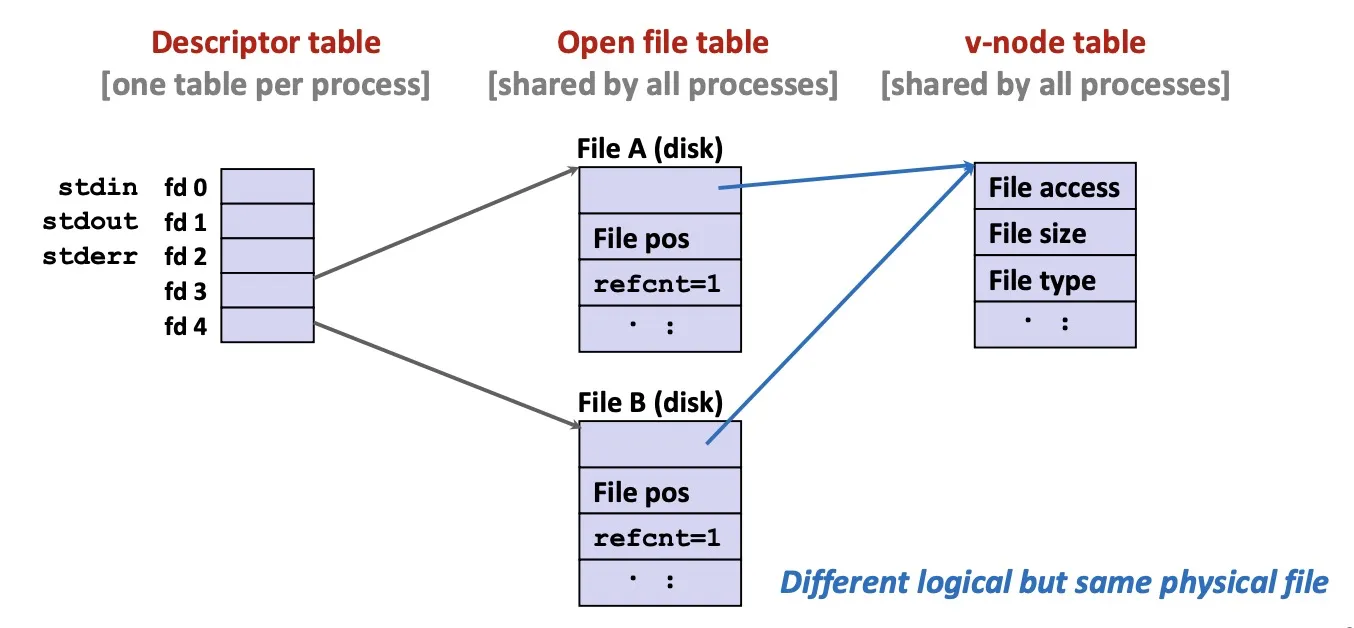
Fork: child’s open file table inherits parent. refcnt++.
IO Redirection: dup2(oldfd, newfd).
Lec 20. Network Programming
network:
- LAN (local area network), spans a building or campus
- WAN (wide area network), spans country or world
- Also SAN (storage area network), …
Internet Protocol (Protocol is a set of rules)
- provides a naming scheme.
- defines a uniform format for host addresses.
- each host (and router) is assigned at least 1 of these unique address.
- provides a delivery mechanism
- defines a standard transfer unit (packet)
- packet consists of header and payload
The Global IP Internet (大写I) is the most famous example of an internet (小写i).
Global IP Internet (upper case I)
based on TCP/IP protocol family
- IP (Internet Protocol)
- provides basic naming scheme, unreliable delivery capability from host-to-host
- UDP (User Datagram Protocol)
- Uses IP to provide unreliable datagram delivery from process-to-process
- TCP (Transmission Control Protocol)
- Uses IP to provide reliable byte streams from process-to-process
Accessed via sockets interface (a mix of Unix file IO and functions)
DNS (domain naming system)
32-bit IP address, always stored in memory in network byte order (big endian byte order)
1 | |
use getaddrinfo and getnameinfo to convert between IP and dooted decimal format.
DNS: mapping between IP and domain names.
nslookup: see the mapping
- 多个域名可以指向同一个IP。
- 有效域名可以不指向任何IP。
TCP connections:
- Point-to-point: connects a pair of processes
- Full-duplex: 数据在同一时刻能够双向传输
- Reliable: 数据发送顺序和接收顺序一样
A socket is an endpoint of a connection (socket addr is IPaddress:port pair)
A port is a 16-bit integer that identifies a process
- Ephemeral port: assigned automatically by client kernel
- Well-known port: e.g. 80 is for web servers.
/etc/services中列出了这些well-known ports